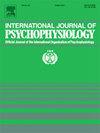Neural markers of human aggression and cooperation are influenced by zero-sum or non-zero-sum groups
IF 2.5
3区 心理学
Q3 NEUROSCIENCES
引用次数: 0
Abstract
Cooperation and competition in social interaction are important to social development. There are many studies examining the neural mechanism underlying these behaviors; however, little is known about the potential role of payoff norms in social interactions. This study introduced two distinct payoff norms: zero-sum (ZS) and non-zero-sum (NZS). In the ZS group, only the player with the highest total score would receive a reward; while in the NZS group, rewards were determined by the combined total score of both players, and individual rewards were prorated according to each player's contribution to the total score. Electroencephalography was used to examine individuals' neural responses during the Chicken Game in these different groups. The behavioral findings revealed a higher rate of cooperation in the NZS group compared to the ZS group. Aggressive behaviors from opponents elicited larger feedback-related negativity (FRN) and lower P300 amplitudes in both groups. Notably, larger FRN and smaller P300 amplitudes were elicited by participants' aggressive behaviors compared to their cooperative behaviors in the ZS group, whereas larger P300 amplitudes were elicited by aggressive behaviors compared to cooperative behaviors in the NZS group. Additionally, a greater theta event-related synchronization (ERS) was observed solely when participants exhibited aggression in the NZS group. The type of group moderated the association between posterior theta-ERS and cooperative rates. Specifically, theta-ERS was negatively associated with cooperative rates in the NZS group, whereas a reversed association was found in the ZS group. These findings provide valuable insights into the neurobiological foundations of cooperation under different economic payoff norms.
求助全文
约1分钟内获得全文
求助全文
来源期刊
CiteScore
5.40
自引率
10.00%
发文量
177
审稿时长
3-8 weeks
期刊介绍:
The International Journal of Psychophysiology is the official journal of the International Organization of Psychophysiology, and provides a respected forum for the publication of high quality original contributions on all aspects of psychophysiology. The journal is interdisciplinary and aims to integrate the neurosciences and behavioral sciences. Empirical, theoretical, and review articles are encouraged in the following areas:
• Cerebral psychophysiology: including functional brain mapping and neuroimaging with Event-Related Potentials (ERPs), Positron Emission Tomography (PET), Functional Magnetic Resonance Imaging (fMRI) and Electroencephalographic studies.
• Autonomic functions: including bilateral electrodermal activity, pupillometry and blood volume changes.
• Cardiovascular Psychophysiology:including studies of blood pressure, cardiac functioning and respiration.
• Somatic psychophysiology: including muscle activity, eye movements and eye blinks.

 求助内容:
求助内容: 应助结果提醒方式:
应助结果提醒方式:


